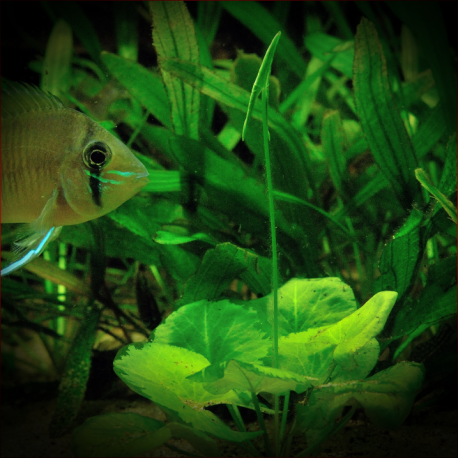More info
Datasheet
| Aquarium Compatible | yes |
| Plant Outdoor | unknown |
| Plant Emersed Growth | unknown |
| Plant Growth | medium |
| Temperature Tolerance | 18°C / 64.40°F - 30°C / 86.00°F |
| Temperature | 24°C / 75.20°F - 28°C / 82.40°F |
| Carbonate Hardness | 0-10 kh |
| pH Value | 5-7 ph |
| Light | medium-high |
| Carbon Dioxide (CO2) | 20-40mg/lmg/l |
| Nitrate (NO3-) | 10-50mg/lmg/l |
| Phosphate (PO43-) | 0.1-3mg/lmg/l |
| Potassium (K+) | 5-30mg/lmg/l |
| Iron (Fe) | 0.01-0.5mg/lmg/l |
General Description
Nymphaea glandulifera, commonly known as Rodschied Water Lily, is a species belonging to the family Nymphaeaceae. Originating from Central America and northern South America, this aquatic plant is categorized under seed plants and has an order of Nymphaeales. With its medium growth difficulty, this plant features rosette and tuber plant types with floating leaves and is suitable for midground and foreground placement in groups within an aquarium setting.
Aquarium Suitability
This water lily is considered suitable for aquariums, although it is rarely commercially available. It may occasionally be sourced from other aquarists who cultivate the plant. The plant's requirements include medium to high light, carbon dioxide levels between 20-40mg/l, and a pH value ranging from 5 to 7. Nitrate levels are recommended to be maintained between 10-50mg/l, with phosphate levels at 0.1-3mg/l and potassium levels between 5-30mg/l. The temperature range for this plant is 24-28°C, with the ability to tolerate temperatures between 18-30°C.
Demands and Hardiness
Nymphaea glandulifera has a medium growth rate and is unsuitable for outdoor use in colder climates, as it is not winter-hardy. The plant can be propagated through runners, making it a suitable choice for aquarists looking to propagate and expand their aquatic plant collection.
Aquascaping & Usage
In aquascaping, the Rodschied Water Lily can be utilized effectively in the midground and foreground of an aquarium, especially when planted in groups. Its rosette growth pattern and tuberous roots make it an attractive addition to aquascapes, adding texture and visual interest to the layout.
Propagation
The propagation of Nymphaea glandulifera is primarily achieved via runners, allowing the plant to produce new growth and expand its coverage within the aquarium. Understanding and facilitating the propagation process can help maintain a healthy and vibrant aquatic environment.
Habitat and Distribution
The natural habitat of Nymphaea glandulifera includes regions in Central America and northern South America. Growing in aquatic environments, this species thrives in suitable water conditions with adequate light and nutrient levels. Its distribution range highlights its adaptability to varying environments within the specified regions.

